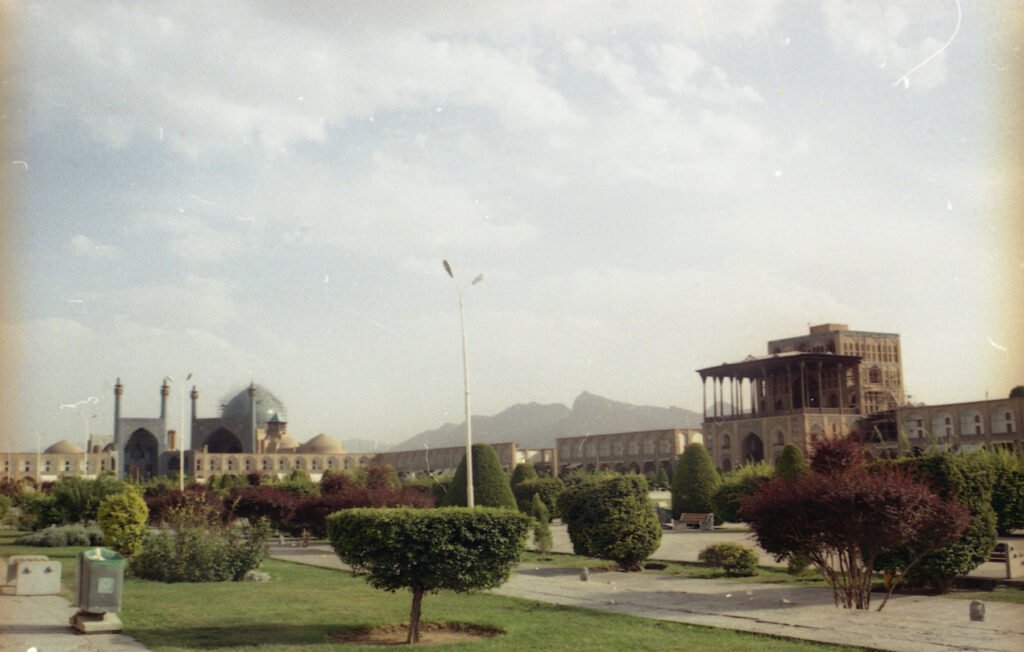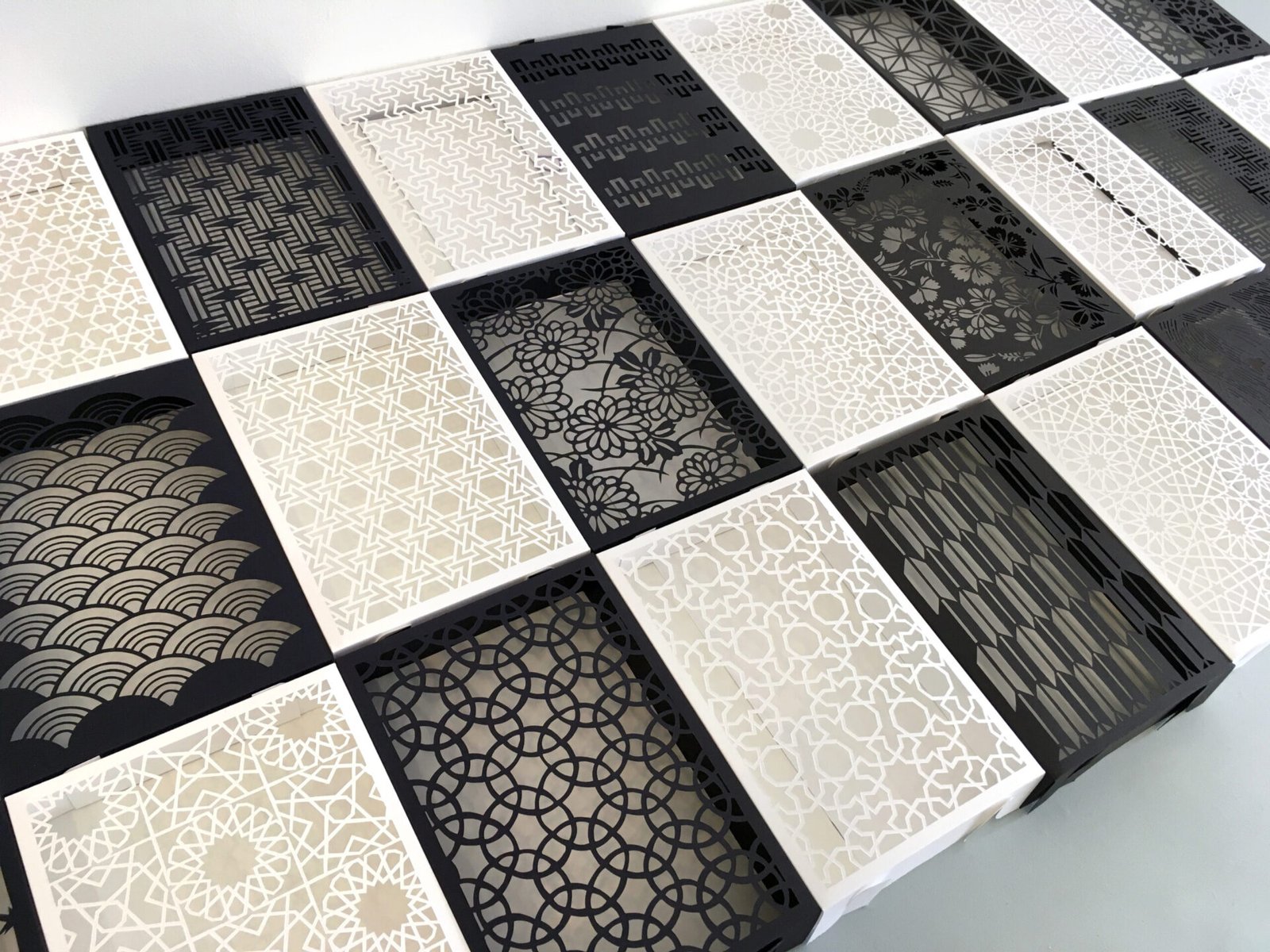Rachael Ashe’s Patterns of Influence is made up of ornamental arrangements, grids and geometric designs that the artist has cut by hand into paper. As per the exhibition’s title, Ashe’s personal experiences and encounters with patterns have influenced the creation of these works. Flanking the back walls of the Craft Council of British Columbia Gallery, Ashe’s variable paper cuts draw the viewer into a pattern-induced daze, encouraging the viewer to consider the geometric designs in the contexts of which the audience knows them.

Walking into the charming Granville Island gallery, I am reminded of the small artisan shops in the bazaars of Iran where craftspeople can be seen at work. In Isfahan, my hometown, notably at the Naqsh-e Jahan Square, craftspeople take residency in highly ritualized spaces where their labor is available to the public to view and admire. Besides the presence of the artist herself making the paper cuts, what distinguishes the Craft Council from the Bazaars of Iran are the sounds of the market – negotiations of prices, tea boiling in kettles, chatter of bazaar conversations and the banging of the coppersmith’s hammer. Ashe’s Patterns of Influence offers a silent counter to this, but make no mistake, both of these spaces nuance the potential of craft by placing emphasis on pattern making, meaning and history.
“Ashe’s variable paper cuts draw the viewer into a pattern-induced daze, encouraging the viewer to consider the geometric designs in the contexts of which the audience knows them”
Ashe’s painstakingly precise work further blurs the transparency of the bazaar, as the audience is led to question the labor of the artist. Though the clear and crisp cuts are made by Ashe’s hand, many assume that they are machine made. When told otherwise, the visitor is left pondering the role of the artisan, their historical legacy, the authority of machine production and the hand’s potential as a tool of production.
Rooted in longstanding traditions of cross-cultural communication, Ashe’s sources stem from Islamic art practices that utilize patterns and geometric shapes in drawings, miniatures, architectural structures, and fabrics. These designs differ greatly throughout diverse Islamic cultures located in West Asia and throughout the world. Problematizing the notion of Islamic art as a static and homogenous label, Ashe’s paper-cut patterns specifically and unambiguously reference Persian Khātam (خاتم) designs. The installation “Patterns of Influence, ”which shares its title with the exhibition, deeply evokes the patterns of traditional Khātam.


Khātam are produced by craftspeople in bazaars throughout Iran: their geometric designs are rhythmic, interlayered and placed with care and intention. The thirty-six three-dimensional paper works that make up “Patterns of Influence” include depictions of flowers, chains and repeating geometric shapes. The same patterns can be found carved onto a handcrafted wooden Khātam box at Naqsh-e Jahan. Placed on a white rectangular plinth, the paper cuts are connected via magnets, a gentle and concealed way of connecting the individual pieces into a whole unit. The individual pieces which make up the three-dimensional installation resemble book covers, but when connected they appear like a rug, blanket, or an intricate doorway.
Applying this narrative in the realm of cross-cultural exchange, what is offered to the viewer through acts of appropriation? It is apparent that Ashe’s practice privileges the individual creator in an otherwise industrialized, anonymous space of production. Attention is awarded to the labour behind conception and construction; the relationship between the product, production and producer is brought to the forefront.
The craftsmen of Naqsh-e Jahan Square share similar concerns with Ashe, not only in their in similar use of pattern, but through their emphasis on repetition and slowness to produce thoughtfully and carefully. These rituals of craft have been practiced for centuries in this place; in the bazaars, method is not reinvented but perfected and revitalized daily. Patterns of Influence evokes a universal solidarity between craft practitioners. Ashe’s work brings to mind the ancient practice of the bazaar craftspeople. She brings a new way of understanding slow and thoughtful craft, halfway across the world.
Bahar Mohazabnia is an Iranian – Canadian MA candidate in the department of Art History at the University of British Columbia, living and working on the unceded lands of the Squamish, Musqueam and Tsleil-Waututh peoples (Vancouver, BC). Bahar holds a Bachelor of Arts degree in Art History with a minor in Classical, Near Eastern and Religious Studies from the University of British Columbia. She is the recipient of the University of British Columbia Faculty of Arts Graduate Award, the Social Sciences and Humanities Research Council (SSHRC) Award and the Helen Belkin Memorial Scholarship. Bahar has held the positions of Curatorial Assistant at Griffin Art Projects (North Vancouver, BC), Exhibition Assistant at AHVA Gallery (Vancouver, BC) and is currently Public Programs Assistant at the Morris and Helen Belkin Art Gallery (Vancouver, BC).

